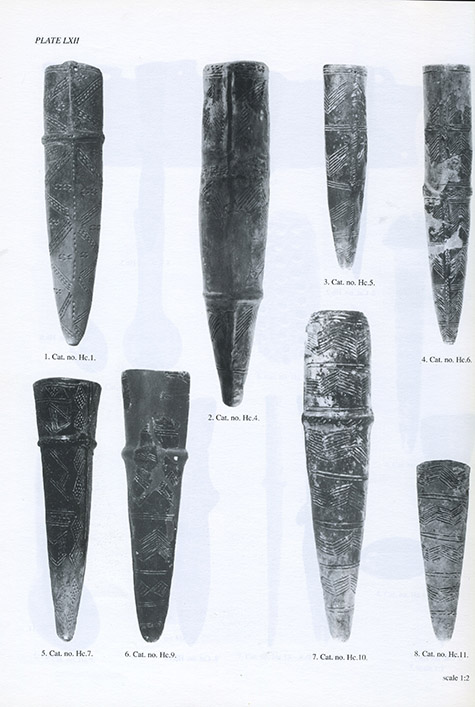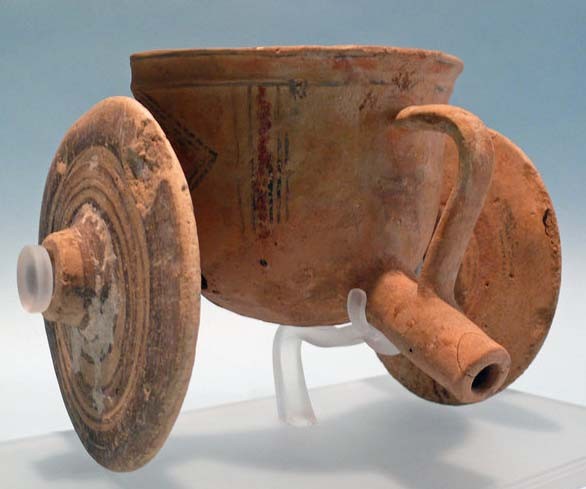| Author |
Message |
|
Tim Junge
|
 Posted: Thu 14 May, 2020 11:54 am Post subject: Historical scabbard fittings Posted: Thu 14 May, 2020 11:54 am Post subject: Historical scabbard fittings |
 |
|
I recognized that a lot of cheaper modern scabbards come with a chape made of leather like this one https://www.wulflund.com/weapons/swords/sword-accessories/medieval-sword-scabbard-roland.html/
I know there were historical scabbards without any chapes and fittings which simply had a leather point. My question is, a this special kind of "leather chapes" historical accurate? I never found them anywhere on any effigies or manuscripts I found so far, and I assume they are a more ahistorical thing.
Thanks in advance guys.
|
|
  |
 |
|
Tyler C.
|
 Posted: Thu 14 May, 2020 1:54 pm Post subject: Posted: Thu 14 May, 2020 1:54 pm Post subject: |
 |
|
Hi Tim,
I've done a fair bit of looking into scabbards of this type and, like you, I have never run into an original example or period art that shows a chape like the one on this scabbard. If I were to hazard a guess, I would guess that this is not period correct. That being said, I haven't seen everything so I am open to correction if I'm out to lunch on this.
|
|
  |
 |
Mikko Kuusirati

|
 Posted: Thu 14 May, 2020 3:34 pm Post subject: Posted: Thu 14 May, 2020 3:34 pm Post subject: |
 |
|
If leather chapes were used, I'd seriously expect them to have the seam on the back instead of along the sides.
"And sin, young man, is when you treat people like things. Including yourself. That's what sin is."
— Terry Pratchett, Carpe Jugulum
|
|
  |
 |
|
Tim Junge
|
 Posted: Mon 25 May, 2020 11:56 am Post subject: Posted: Mon 25 May, 2020 11:56 am Post subject: |
 |
|
| Mikko Kuusirati wrote: | | If leather chapes were used, I'd seriously expect them to have the seam on the back instead of along the sides. |
Someone pointed out to me that some katzbalger scabbards had reinforced leather tips not to different from these ones. I kind of remembered seeing some of those when I found out. But on longsword scabbards that really looks like a modern invention.
| Mikko Kuusirati wrote: | | If leather chapes were used, I'd seriously expect them to have the seam on the back instead of along the sides. |
I could imagine that it's really hard to attach a chape made of leather that way. I could imagine that it would have to be glued in place that way.
|
|
  |
 |
|
David JD Johnson
Location: London UK Joined: 24 May 2020
Posts: 19
|
 Posted: Tue 26 May, 2020 5:44 am Post subject: scabbards/sheaths 2200 BC Posted: Tue 26 May, 2020 5:44 am Post subject: scabbards/sheaths 2200 BC |
 |
|
People might be interested that some of the pottery objects put in Cypriot tombs 2300-2100 BC were (as well as actual spear blades, knives and daggers) were ceramic models of daggers and their sheaths.
Here is a page of photos of the sheaths, clearly showing seams in the leather and stitching (shown with incisions in the pottery)
 Attachment: 98.71 KB Attachment: 98.71 KB

http://ant.david-johnson.co.uk
http://david-johnson.co.uk
|
|
  |
 |
Kai Lawson

|
 Posted: Tue 26 May, 2020 10:41 am Post subject: Posted: Tue 26 May, 2020 10:41 am Post subject: |
 |
|
That’s is super cool!! Do you have a link to any publications/reports or more photos?
"And they crossed swords."
--William Goldman, alias S. Morgenstern
|
|
  |
 |
|
David JD Johnson
Location: London UK Joined: 24 May 2020
Posts: 19
|
 Posted: Fri 29 May, 2020 8:18 am Post subject: Posted: Fri 29 May, 2020 8:18 am Post subject: |
 |
|
It is from volume 1 (out of 6) of Vassos Karageorghis's 6 volume work on Cypriot ceramic representations (mostly people and bulls but a variety of other things) The first volume goes up to about 1000BC.
You can find my collection on http://david-johnson.co.uk
Here is a model chariot I own from about 7th century BC (ie roughly the time of Homer) Originally it had a small rider modelled against the front edge (you can see where it snapped off. There are a few others like this, probably made to go into the tomb it was found in, and the figures seems too smaller the chariot, so it has been speculated it might represent a chariot taking the spirit to the afterlife.
 Attachment: 36.66 KB Attachment: 36.66 KB

http://ant.david-johnson.co.uk
http://david-johnson.co.uk
|
|
  |
 |
|
Tim Junge
|
 Posted: Sun 14 Jun, 2020 4:02 am Post subject: Re: scabbards/sheaths 2200 BC Posted: Sun 14 Jun, 2020 4:02 am Post subject: Re: scabbards/sheaths 2200 BC |
 |
|
| David JD Johnson wrote: | People might be interested that some of the pottery objects put in Cypriot tombs 2300-2100 BC were (as well as actual spear blades, knives and daggers) were ceramic models of daggers and their sheaths.
Here is a page of photos of the sheaths, clearly showing seams in the leather and stitching (shown with incisions in the pottery) |
Thanks, that's very insightful and interesting. I agree, that definitly looks like stiching.
|
|
  |
 |
Harry Marinakis

|
 Posted: Mon 29 Jun, 2020 11:57 am Post subject: Posted: Mon 29 Jun, 2020 11:57 am Post subject: |
 |
|
Everyone wants a fancy chape, but in reality a common "munitions grade" chape is easy to make without a lot of tools.
Get a sheet of 22 gauge brass or mild steel, wrap it around the tip of the scabbard, and cut it straight across the top. You can solder the flaps closed if you want, but that's not necessary. Then cut off the pointed tip, cut into four flaps, and fold over the flaps. Done.
See this thread over a Armour Archive:
http://forums.armourarchive.org/phpBB3/viewto...p;start=70
|
|
  |
 |
|
Tim Junge
|
 Posted: Wed 01 Jul, 2020 2:42 am Post subject: Posted: Wed 01 Jul, 2020 2:42 am Post subject: |
 |
|
| Harry Marinakis wrote: | Everyone wants a fancy chape, but in reality a common "munitions grade" chape is easy to make without a lot of tools.
Get a sheet of 22 gauge brass or mild steel, wrap it around the tip of the scabbard, and cut it straight across the top. You can solder the flaps closed if you want, but that's not necessary. Then cut off the pointed tip, cut into four flaps, and fold over the flaps. Done.
See this thread over a Armour Archive:
http://forums.armourarchive.org/phpBB3/viewto...p;start=70 |
I actually don't like those chapes like the one in my example very much and I can get a new chape made of metal for like 3€. But I was interested in the historical accuracy of those types.
But thanks for the addition.
|
|
  |
 |
|
|

